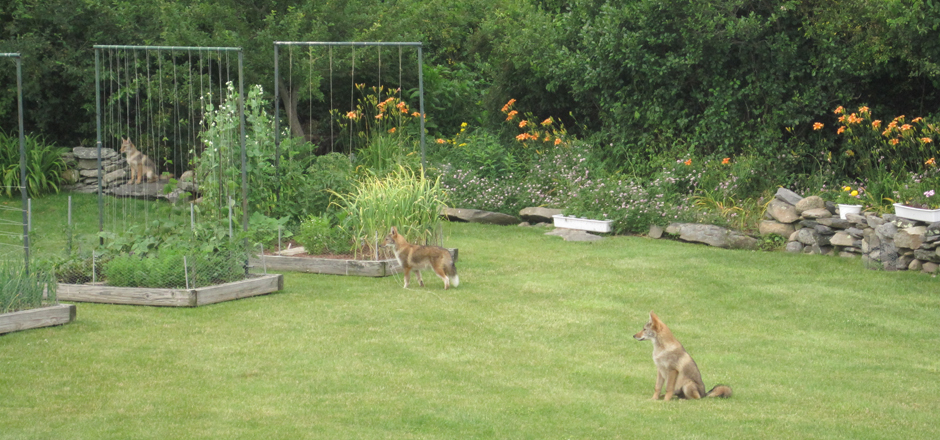A: Coyotes were first documented in Rhode Island in the late 1960s and are found in all parts of the state except Block Island. A major research project, the
Narragansett Bay Coyote Study, has been underway since 2004 to study the coyotes of Aquidneck and Conanicut Islands in order to develop science-based coexistence and management strategies.
A: It is always open season on coyotes in Rhode Island. They can be taken at any time of the year by any means, although city and town ordinances may restrict hunting or the discharge of firearms in residential areas and the use of foothold traps, snares or poison is prohibited statewide. Complete rules and regulations are available from the RI Division of Fish and Wildlife at 401-789-0281.
A: Coyotes have an important role to play in the ecosystem. They are considered a keystone species, whose presence or absence has a major effect on the surrounding biological community. As top predators, they help control pests such rodents, rabbits, deer and geese. They have also been found to benefit bird populations by preying on many of the small mammals that prey on the birds, their young or their eggs.
A: Coyote attacks on humans are rare and seldom result in serious injuries. Only two deaths have ever been documented—a toddler in California in 1981 and a 19-year-old woman hiking alone in Nova Scotia in 2009. Children are more at risk than adults, and attacks are more common in urban areas where coyotes have lost their fear of humans thanks to intentional or unintentional feeding.
A: While susceptible to rabies, coyotes are not frequent carriers of the “raccoon” strain of the virus that is found in Rhode Island and other parts of New England. However, they can be hosts to a wide variety of parasites, including ticks, fleas, intestinal worms and heartworms, and may also be infected with canine distemper, parvovirus and mange.
A: Coyotes are sometimes mistaken for dogs and may at times act like dogs. They’ve even been known to beg for food. Despite this disarming behavior, they are a wild and dangerous animal, especially when they’ve lost their fear of humans. Coyotes have a place in nature but not as people’s pets.
A: While wolves are larger and bulkier, coyotes have bushier tails. Coyotes run with their tails down, while dogs run with their tails up and wolves with their tails straight. Wolves hunt in packs, while coyotes hunt primarily in pairs. A wolf’s call is a sustained howl while a coyote’s rises and falls. Coyotes are more adaptable than wolves and have learned to thrive in close proximity to humans.
A: A coywolf is a wolf/coyote hybrid found in parts of eastern Canada where a small wolf population continues to exist and interbreeding with coyotes sometimes occurs. While our coyotes share some of the wolf DNA their ancestors picked up on the way through Canada, they are not currently hybridizing with wolves, and are genuine “eastern coyotes” (Canis latrans thamnos).
A: A coydog is a dog/coyote hybrid that is more myth than reality, due primarily to the difference in breeding cycles. While coydogs do exist as rare individuals, there is little genetic evidence of extensive dog/coyote interbreeding.
A: Habituated coyotes are those that have lost their natural fear of people. Historically, people have hunted and trapped coyotes which, over the years, has caused modern-day coyotes to have a good healthy fear of humans. This natural skittishness can disappear when coyotes receive food from people, however. Coyotes emboldened by food rewards from people do not distinguish between small pets and other handouts and can be aggressive. Attacks on humans have occurred, generally near sites where people feed them.
A: Coyotes often treat dogs smaller than 40 pounds as prey. Owners increase the chances of dog predation by letting them out after dark or not accompanying small pets outside. Coyotes are apt to treat dogs larger than 40 pounds as equals—often avoiding them or sometimes engaging them in fights or even play. Older dogs, even if they are large, or any tied dog may be vulnerable to coyote attack. Nighttime—aka “coyote business hours”— is particularly dangerous because even unhabituated coyotes can be drawn to a yard with an unattended dog. Owners should accompany smaller dogs at all times when they are outside or in areas with inadequate fencing.
A: A safe cat is an indoor cat. Older, less agile cats or naive youngsters are most vulnerable to coyote predation. Nighttime—“coyote business hours”—is the most dangerous. Generally, a cat that wanders will be at greater risk than one that says near home and has known escape routes (trees or areas below porches, etc.).
A: Healthy horses and cattle are generally large enough to be able to defend against coyote attacks. Calves and foals can be at risk, however, as can smaller livestock like sheep or goats. A good plan is never to let coyotes get a taste of your livestock. For example, coyotes that haven’t tasted sheep often pass by even poorly-fenced pens containing them to get to fields where they can catch mice (a natural prey item). Once they experience lamb-chops, however, some coyotes will relentlessly go after lambs from there on out. Livestock killing, with the inherent reward of a delicious meal, is a difficult cycle to break without lethal control. Since lethal control is not an effective long-term solution to the coyote problem, it is much easier to be proactive about common-sense protection for your animals.
It can be challenging and expensive to create “coyote-proof” livestock fencing. Coyotes, like raccoons, can flatten and squeeze through or under six-inch-wide gaps in fencing (often found at a gate or at the bottom of the fence). Depending on your budget, it may be a better plan to bring sheep or goats into sheds or barns at night or keep guard animals with them (see also Management Tools). Completely dispose of all livestock remains, afterbirth, etc., where coyotes cannot access them. If coyotes get a taste of your livestock, it will train them to prey on additional animals.
A: Do not be afraid if you see a coyote crossing your yard or hear them nearby. In the mixed residential and natural landscapes of Aquidneck Island and Jamestown, coyotes are around us all the time, although we usually are not aware of them. Occasionally they take a shortcut through a yard on the way to a mousing-field or some other natural foraging area and they yip and howl to communicate. You need not be alarmed, but if you wish to discourage a coyote from cutting through, yell to alarm it and throw whatever is at hand to make it feel unwelcome.
A: If coyotes stand their ground for more than a few seconds after you appear, it is not normal. Make loud noises and throw anything at hand and they should leave. If they do not leave or instead move towards you, it is a concern. It is likely that they are expecting to be fed. Back off and notify police that you have encountered habituated coyotes. Give them the location. Do not walk in this area with small pets or children until the issue is resolved.
A: Coyote scat is digestive waste. Scat location can have no meaning or scat placement can serve as a “signpost” emphasizing that an area is part a pack’s territory. The Narragansett Bay Coyote Study has determined that scats are usually present in important parts of coyote territory that the resident coyote pack will defend from other coyotes. If your yard is being marked with scat, there may be a den nearby or there may be important food resources near your home. Scat in neighborhoods is most commonly seen if someone nearby is regularly leaving out bread or pet food where coyotes access it.
A: It is illegal to relocate problem coyotes in Rhode Island. That simply moves the problem to another community.
Photo credit: ©Bob King, Middletown, RI. Courtesy of The Conservation Agency photo archives.


